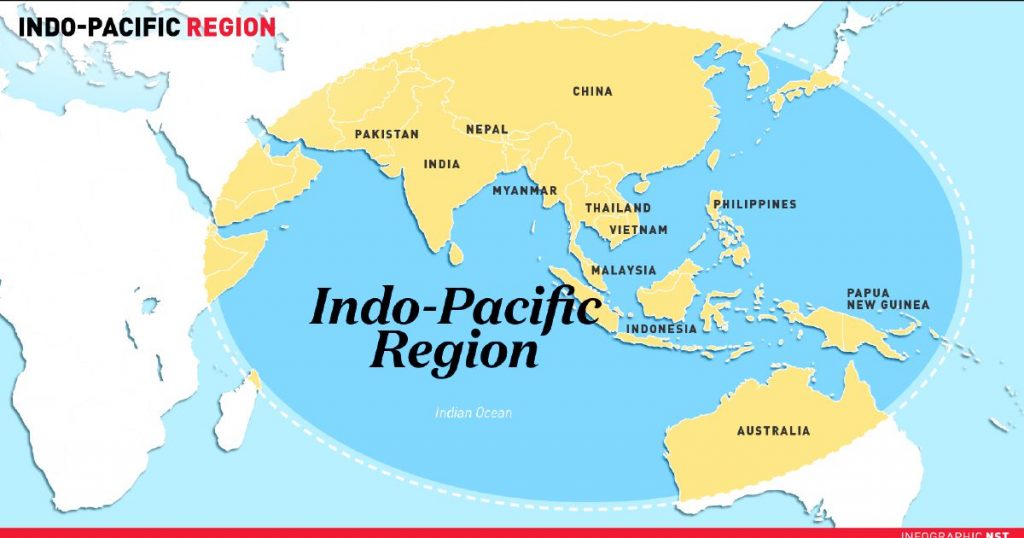
- The White House has declassified the United States Strategic Framework for the Indo-Pacific, a document which has provided strategic guidance for implementing the 2017 National Security Strategy in the world’s most populous and economically dynamic region.
- The US states that the most consequential challenge to the interests of the United States, and those of our allies and partners, is the growing rivalry between free and repressive visions of the future.
- The framework recognises that Beijing is increasingly pressuring Indo-Pacific nations to subordinate their freedom and sovereignty to a “common destiny” envisioned by the Chinese Communist Party.
- The Framework calls to enhance U.S. engagement in the region while also educating governments, businesses, universities, Chinese overseas students, news media, and general citizens about China’s coercive behavior and influence operations around the globe.
- The US says that the Framework seeks to strengthen the US’ wide and diverse network of allies and partners, which has long underwritten stability and peace in the Indo-Pacific.
- The Framework states that “A strong India, in cooperation with like-minded countries, would act as a counterbalance to China” as it maintains the capacity to counter border provocations by China, it states.
- However, the US framework grants itself the leadership role given its “history of fighting back against repressive regimes”. The Framework clearly works on the principles of how the US can maintain its strategic primacy in the Indo-Pacific region, albeit in the name of countering China.
- It is for India to decide if it will just tag along with the US as a pawn in its game or emerge stronger in the region as a global player with its own strategic framework in which other democratic countries find a place.
- India has to deepen its ties with the ASEAN and Pacific countries on its own strengths and in mutual interests. India has the advantage of its centuries old cultural ties with many of these countries. Strengthening of the IORA will be a step in this direction.
- The world has seen what the US has done and can do to countries where it has intervened on the pretext of ‘restoring democracy’! The Indo-Pacific countries will decide what’s best for them and work out relations and solve issues on their own terms.
On January 12, 2021, US National Security Advisor Robert C. O’Brien said that the White House has declassified the United States Strategic Framework for the Indo-Pacific, a document which has provided strategic guidance for implementing the 2017 National Security Strategy in the world’s most populous and economically dynamic region.
The Framework was approved by the Trump administration in February 2018 for implementation across Executive Branch departments and agencies. NSA O’Brien said that the document is being released in order to “communicate to the American people and to our allies and partners the enduring commitment of the United States to keeping the Indo-Pacific region free and open long into the future”.
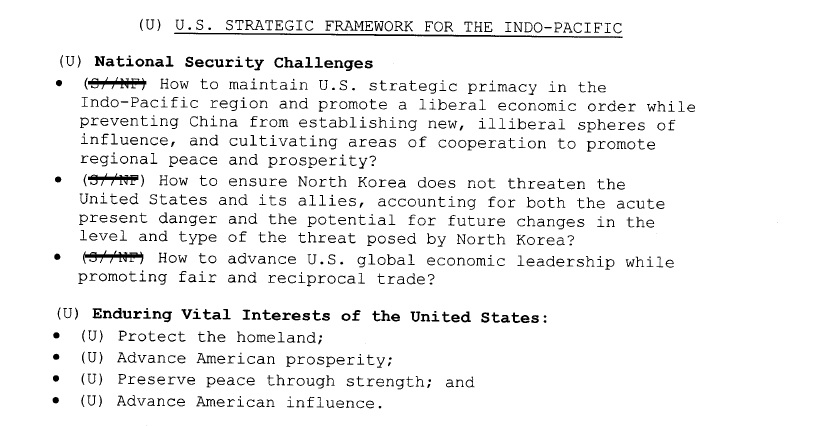
Calling for a ‘Free and Open Indo-Pacific’, the NSA’s statement claims that the US ‘is and always has been an Indo-Pacific nation’. “From our first trading ships that departed for China just eight years after the American Revolution, to establishing our first diplomatic presence in India in 1794, U.S. engagement in the region has been built on trade, cooperation, and shared sacrifice, yielding the peace and prosperity enjoyed across the region today”.
The US states that the most consequential challenge to the interests of the United States, and those of our allies and partners, is the growing rivalry between free and repressive visions of the future. In order to realize America’s positive vision for the region, and to
address the unprecedented challenges that Indo-Pacific nations face to their sovereignty, prosperity, and peace, President Trump had approved the Strategic Framework for the Indo-Pacific in February 2018 for implementation across Executive Branch departments and agencies.
On Countering China
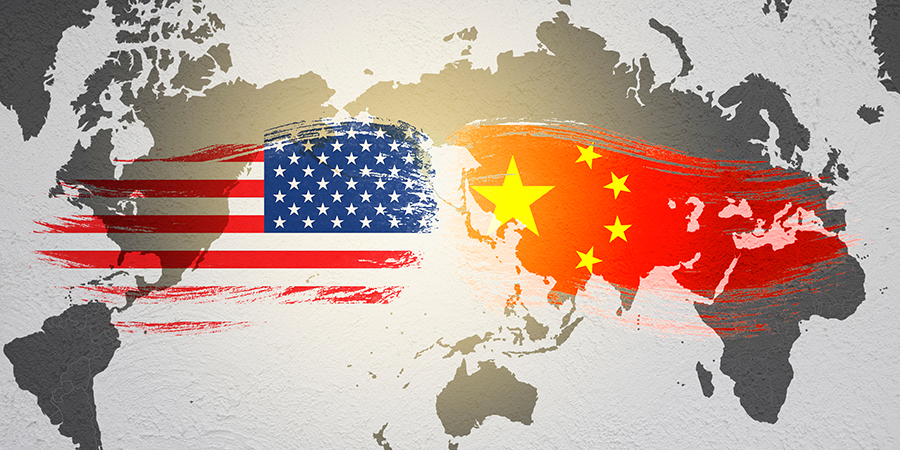
The framework recognises that Beijing is increasingly pressuring Indo-Pacific nations to subordinate their freedom and sovereignty to a “common destiny” envisioned by the Chinese Communist Party. The U.S. claims that it’s approach is different and seeks to ensure that its allies and partners – all who share the values and aspirations of a free and open Indo-Pacific – can preserve and protect their sovereignty.
The NSA says that the Framework has guided the development of numerous subordinate policy frameworks and campaign plans that have steered the U.S. approach to specific issues of importance to the Indo-Pacific region and beyond, such as the U.S. Strategic Approach to the People’s Republic of China, the U.S. Strategic Framework for Countering China’s Economic Aggression, the U.S. Campaign Plan for Countering China’s Malign Influence in International Organizations, and others.
Together with its subordinate documents, the Framework has guided U.S. whole-of-government actions to advance regional prosperity and stability, including sovereignty, freedom of navigation and overflight, reciprocity in trade and investment, respect for individual rights and rule of law, and transparency, says the NSA.
The Framework itself states that “China will circumvent international rules and norms to gain an advantage” as it aims to dissolve U.S. alliances and partnerships in the region. “China will exploit vacuums and Opportunities created by these diminished bonds”, it states.
Chinese economic, diplomatic, and military influence will continue to increase in the near-term and challenge the U.S. ability to achieve its national interests in the Indo-Pacific region. China seeks to dominate cutting-edge technologies, including artificial intelligence and bio-genetics, and harness them in the service of authoritarianism. Chinese dominance in these technologies would pose profound challenges
to free societies, states the Framework.
It further states that China’s proliferation of its digital surveillance, information controls, and influence operations will damage U.S. efforts to promote its values and national interests in the Indo-Pacific region and, increasingly, in the Western hemisphere and at home. China will take increasingly assertive steps to compel unification with Taiwan, it asserts.
In order to prevent China’s industrial policies and unfair trading practices from distorting global markets and harming U.S. competitiveness, the Framework calls for several actions. These include countering Chinese predatory economic practices that freeze out foreign competition, undermine U.S. economic competitiveness, and abet the Chinese Communist Party’s aspiration to dominate the 21st century economy. It then calls to build an international consensus that China’s industrial policies and unfair trading practices are damaging the global trading system.
In order to maintain American industry’s innovation edge vis-a-vis China, it calls to work closely with allies and like-minded countries to prevent Chinese acquisition of military and strategic capabilities; broaden the scope of the Committee on Foreign Investment in the United States to cover venture capital and other forms of investment by China; and adopt domestic policies that promote growth in key technologies.
In order to deter China from using military force against the United States and U.S. allies or partners, and develop the capabilities and concepts to defeat Chinese actions across the spectrum of conflict, the Framework calls to enhance combat-credible U.S. military presence and posture in the Indo-Pacific region, to uphold U.S. interests and security commitments. It also calls to help US allies and partners improve their security posture, including military capabilities and interoperability, to ensure strategic independence and freedom from Chinese coercion. Expand partnerships and capabilities that limit China’s ability to coerce allies and partners.
The Framework also calls to enhance U.S. engagement in the region while also educating governments, businesses, universities, Chinese overseas students, news media, and general citizens about China’s coercive behavior and influence operations around the globe.
In order to maintain an intelligence advantage over China, and inoculate the United States, its allies, and partners against Chinese intelligence activities, the Framework says that the US must equip its allies and partners to cooperate with the United States in operating against China and countering China’s clandestine activities in their countries. It also says that there is a need to expand and prioritize U.S. intelligence and law enforcement activities that counter Chinese influence operations and get like-minded countries to do the same.
It calls to strengthen defensive and offensive counterintelligence functions across the public and private sectors to neutralize China’s growing intelligence advantages; expand intelligence diplomacy and law enforcement cooperation with other governments to bolster understanding of Chinese intentions and capabilities.
This has to be done by helping allies and partners develop high standards in counterintelligence, counter proliferation, cyber security,
industrial security, and management of classified information, says the Framework.
Allies and Partners
The NSA says that the Framework seeks to strengthen the US’ wide and diverse network of allies and partners, which has long underwritten stability and peace in the Indo-Pacific. To that end, the Framework reflects the importance of supporting allies’ and partners’ complementary approaches to regional engagement. These approaches include Japan’s Free and Open Indo Pacific concept, Australia’s Indo-Pacific concept, India’s Security and Growth for All Regions A Free and Open Indo-Pacific policy, the Republic of Korea’s New Southern Policy, Taiwan’s New Southbound Policy, and the Association of Southeast Asian Nations’ (ASEAN) Outlook on the Indo-Pacific. Many of these concepts and approaches are resonating globally, with countries such as France and Germany publishing their own policy frameworks for the Indo-Pacific.
The NSA claims that the US by working collaboratively, has identified participants based on common principles shared by diverse countries all over the region. These principles included the importance of sovereignty, rule of law, and accountability to the public; the centrality of ASEAN in regional architecture; the importance of open commons of the sea, overflight, and cyberspace; the peaceful resolution of territorial and maritime disputes; free, fair, and reciprocal trade; and investment and regional integration through connectivity and investment projects that are financed transparently and improve social and environmental outcomes, says the NSA’s statement.
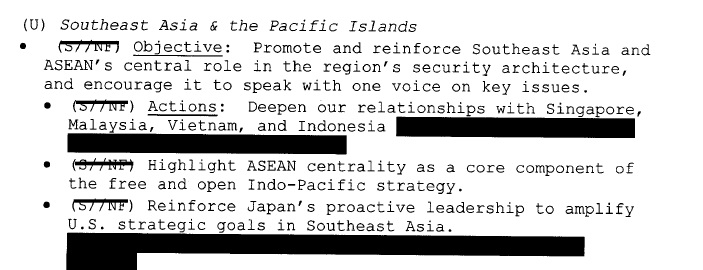
The declassification of the Framework demonstrates, with transparency, America’s strategic commitments to the Indo-Pacific and to our allies and partners in the region, claims the NSA. The NSA’s statement quotes President Trump who in Vietnam in 2017 said the United States views the Indo-Pacific region as “a beautiful constellation of nations, each its own bright star, satellites to none – and each one, a people, a culture, a way of life, and a home”. As long as nations work together to keep the region free and open, we can ensure that this vision continues to inspire long into the future, says the NSA.
The Framework calls to invigorate U.S. technical assistance to friendly governments to promote rule of law and civil institutions while communicating the strings attached to China’s “Belt and Road Initiative.” It also says the US has to Develop a robust public diplomacy capability, which can compete with China’s information campaigns; puncture the narrative that Chinese regional domination is inevitable.
India as an Ally
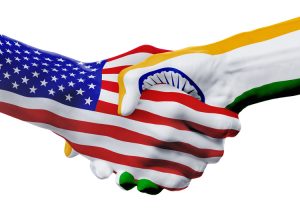
After stating the reasons and rationale behind countering China, the Framework states that “A strong India, in cooperation with like-minded
countries, would act as a counterbalance to China”.
India’s preferred partner on security issues is the United States. The two cooperate to preserve maritime security and counter Chinese influence in South and Southeast Asia and other regions of mutual concern. India maintains the capacity to counter border provocations by China, it states.
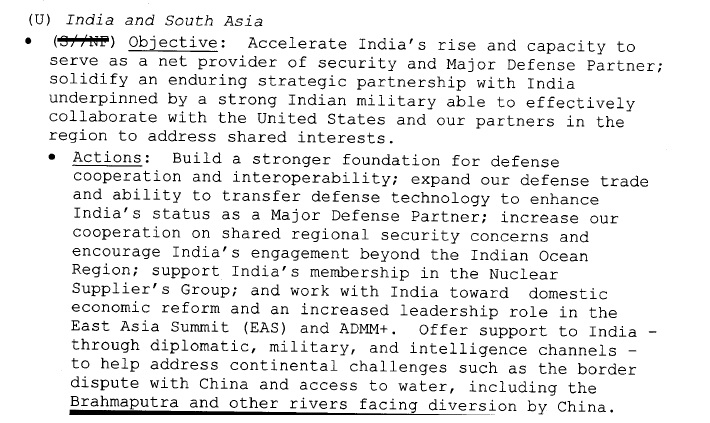
On the future of the region, the Framework says India remains preeminent in South Asia and takes the leading role in maintaining Indian Ocean security, increases engagement with Southeast Asia, and expands its economic, defense, and diplomatic cooperation with other U.S. allies and
partners in the region.
On India and South Asia, the Framework states the objective to accelerate India’s rise and capacity to serve as a net provider of security and Major Defense Partner; solidify an enduring strategic partnership with India underpinned by a strong Indian military able to effectively
collaborate with the United States and its partners in the region to address shared interests.
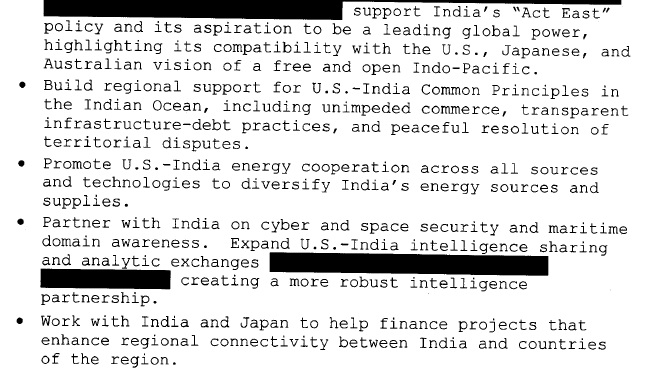
As part of action items, the Framework calls for a number of measures.
- Build a stronger foundation for defense cooperation and interoperability; expand US defense trade and ability to transfer defense technology to enhance India’s status as a Major Defense Partner; increase US cooperation on shared regional security concerns and encourage India’s engagement beyond the Indian Ocean Region; support India’s membership in the Nuclear Suppliers Group; and work with India toward domestic economic reform and an increased leadership role in the East Asia Summit (EAS) and ADMM+. Offer support to India -through diplomatic, military, and intelligence channels -to help address continental challenges such as the border dispute with China and access to water, including the Brahmaputra and other rivers facing diversion by China.
- It also calls to support India’s “Act East” policy and its aspiration to be a leading global power, highlighting its compatibility with the U.S., Japanese, and Australian vision of a free and open Indo-Pacific.
- It further calls to build regional support for U.S.-India Common Principles in the Indian Ocean, including unimpeded commerce, transparent infrastructure-debt practices, and peaceful resolution of
territorial disputes. - Promote U.S.-India energy cooperation across all sources and technologies to diversify India’s energy sources and supplies.
- Partner with India on cyber and space security and maritime domain awareness. Expand U.S.-India intelligence sharing and analytic exchanges creating a more robust intelligence partnership.
- Work with India and Japan to help finance projects that enhance regional connectivity between India and countries of the region.
US grants itself the leadership role

However, the US framework grants itself the leadership role given its “history of fighting back against repressive regimes”. The NSA’s statement states, “The Framework recognizes that a free and open Indo-Pacific depends on robust American leadership. The United States has a long history of fighting back against repressive regimes on behalf of those who value freedom and openness. As the world’s largest economy, with the strongest military and a vibrant democracy, it is incumbent on the United States to lead from the front”.
The Framework clearly works on the principles of how the US can maintain its strategic primacy in the Indo-Pacific region, albeit in the name of “promoting a liberal economic order while preventing China from establishing new, illiberal spheres of influence”. The Framework also works to ensure North Korea does not threaten the United States and its allies, accounting for both the acute present danger and the potential for future changes in the level and type of the threat posed by North Korea.
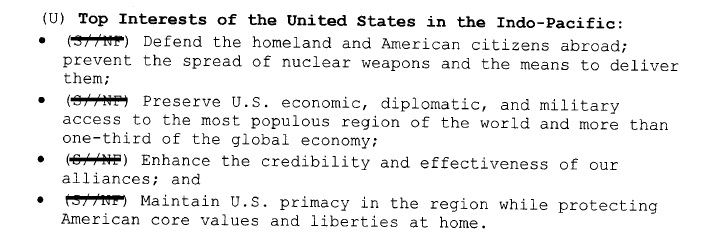
The prime interests of the Framework as stated are for ‘Enduring Vital Interests of the United States’ which can be achieved by:
1) Protect the homeland;
2) Advance American prosperity;
3) Preserve peace through strength; and
4) Advance American influence.
The Framework says that the loss of U.S. preeminence in the Indo-Pacific would weaken its ability to achieve U.S. interests globally. “Strong U.S. alliances are key to deterring conflict and advancing our vital interests”, it says.
Should India cheer or be Circumspect?
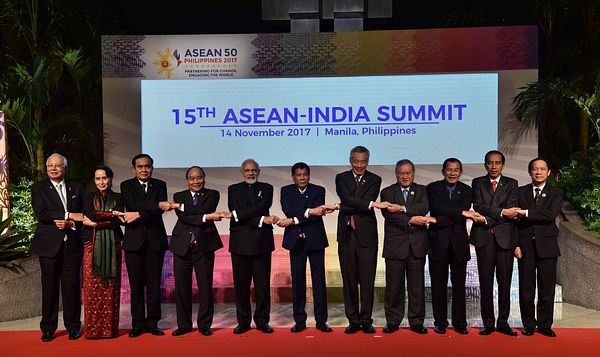
The declassification of the US Strategic Framework comes at a time when the United States is undergoing a rather patchy transition of power. While Trump openly criticised China and called for counter measures, President-elect Biden may not be as blatant in his opposition to China. Nevertheless, given the threats it faces from China, the US is expected to more or less follow a similar strategic framework even under a new President.
It is for India to decide if it will just tag along with the US as a pawn in its game or emerge stronger in the region as a global player with its own strategic framework in which other democratic countries find a place. India since 2014 has indeed made great strides in posturing itself as a global power both in terms of economic clout and military strength. The same is reflected in the just declassified US strategic framework.
Though India should certainly be happy that the US sees it as a powerful ally in the region, it should surely not play the role of a minion. It will be for India to decide its path and relations with any country including China. India today is capable enough to handle or country any country on its own without being a part of someone else’s framework.
The US framework is also a cause of concern when scrutinised in the context of India’s own interests. On one hand it openly gives itself a leadership role thus relegating India to a lower role that adheres to larger interests of the US.
Further, the framework calls for ‘promotion of U.S. values throughout the region’ in order to maintain influence and counterbalance Chinese models of government. But it further calls for ‘Support activists and reformers throughout the region’. This is a cause for concern for a democratic country like India. As witnessed many times in the past, many NGO’s, Human Rights organisations have played havoc with India’s internal affairs in the name of promoting US values. This assertion in the Framework should worry India and be circumspect about the overall intent of the US in the region.
The Indo-Pacific region is grappling with several issues which are historic nature, which have existed for more than seven decades, and recently cropped up issues due to overbearing measures by expansionist forces. However, the very same Indo-Pacific countries are mature and capable enough to handle forces inimical to their interests without external intervention. Countries like the US at the most have the role of an adviser to counter hegemonistic forces like China but cannot grant themselves the role of the arbitrator and judge.
In this aspect, India has to deepen its ties with the ASEAN and Pacific countries on its own strengths and in mutual interests. India has the advantage of its centuries old cultural ties with many of these countries. Strengthening of the IORA will be a step in this direction. Though China and its overbearing attitude has to be countered at all costs, the region cannot let US or other forces dictate terms and conditions to it.
The world has seen what the US has done and can do to countries where it has intervened on the pretext of ‘restoring democracy’! The Indo-Pacific countries will decide what’s best for them and work out relations and solve issues on their own terms. The declassification of the US Strategic Framework is a reminder for all the Indo-Pacific countries to get their act together unless they wish to become minions of a high-handed force thousands of miles away or closer home.
